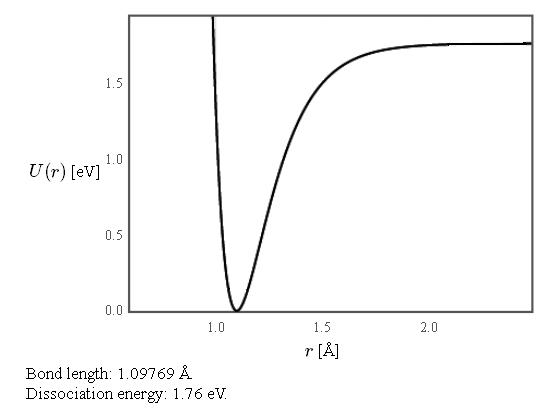
Problem 1
The Morse potential for a N2 molecule is shown below.

(a) How can this bond potential be calculated?
(b) How can this information be used to calculate the frequencies of light that will be absorbed by an N2 molecule? Consider the electronic, vibrational, and rotational energy levels.
Problem 2
A simple cubic crystal with lattice constant $a$ is cut so the (110) plane appears on the surface. The surface atoms form a two-dimensional crystal.
(a) What are the primitive lattice vectors of this two-dimensional crystal?
(b) Draw the Wigner-Seitz cell and the first Brillouin zone of the two-dimensional crystal. Label the size of of the unit cell and Brillouin zone in terms of $a$.
Problem 3
(a) Draw approximately the electron dispersion relation and the density of states for the one-dimensional potential, $V(x) = \cos\left(\frac{2\pi x}{a}\right)$ eV.
(b) There are 3 electrons per primitive unit cell, draw the position of the chemical potential in the plots of the dispersion relation and the density of states.
(c) Is this material a metal, a semiconductor, or an insulator? Why?
Problem 4
Silicon is doped with phosphorus (a donor) to a concentration of 1016 cm-3. The temperature dependence of the electron density in the conduction band can be divided into three regimes: the freeze out regime, the extrinsic regime, and the intrinsic regime.
(a) Sketch a plot of the electron concentration in the conduction band as a function of temperature. Give formulas for the concentrations in the three regimes if you can.
(b) Approximately what temperature divides the freeze out regime from the extrinsic regime? Approximately what temperature separates the extrinsic regime from the intrinsic regime?
The donor level of phosphorus is 45 meV below the conduction band edge. The bandgap of silicon is 1.12 eV.